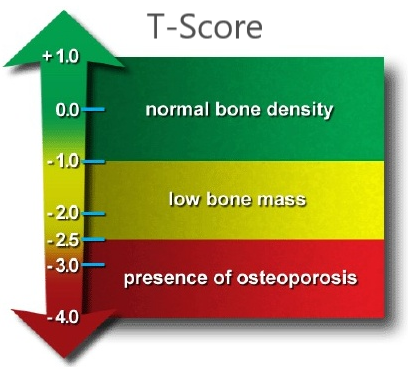New Methods of Diagnosing Who Will Suffer a Bone Fracture
The current method of screening for risk of a fragility fracture is a dual-energy X-ray absorptiometry scan commonly referred to as DXA. The scan measures bone mineral density (BMD) and provides the patient and practitioner with a reading (T-score) that is used to determine if the patient has bone loss requiring treatment to prevent fracture:

- A patient is said to have normal bone when the T-score is higher than -1.0 SD.
- A patient is diagnosed with osteopenia when the T-score is between -1.0 and-2.5 SD.
- A patient is diagnosed with osteoporosis if the T-score is -2.5 SD or less.
These readings commonly dictate treatment. If the BMD is normal, then the assumption is that the patient’s bones are fine with nothing to worry about. If osteopenia is diagnosed, then the decision may be made to monitor the BMD rather than treat the bone loss. If osteoporosis is diagnosed, then treatment is advised.
This is all pretty simple right?
Unfortunately, it is not so simple because 70% of women that sustain a fragility fracture have osteopenia or normal BMD and not osteoporosis.
The problem is that BMD only measures the amount of mineral in your bones. It does not measure the structural integrity of your bones. While there is a linear relationship between low BMD and fracture incidence, there is an exponential relationship between structural deterioration and bone fragility. The message is that the current method of testing using DXA is helpful but not adequate to prevent the majority of fragility fractures.
Micro-CT scans have been used by bone scientists to study the structure of bone for many years and they give a remarkable degree of detail about bone quality. SteinerBio/OsNovum was one the earliest users of the technology to scientifically analyze the bone structure produced by our regenerative materials. However, we now have a Micro-CT scan called a high resolution peripheral quantitative computed tomography (HR-pQCT), which has been cleared by the FDA for use in humans. The following is a chart of a Micro-CT scan of human bone regenerated by SteinerBio/OsNovum technology. Eight weeks after treatment, the Micro-CT scan data shows bone of normal density and normal structural integrity.

The HR-pQCT takes the above type of data and produces a structural fragility score (SFS) that determines the structural integrity of the bones independent of the BMD.
Irrespective of the BMD classification (normal, osteopenia, or osteoporosis), women with an SFS score of >70 had a two to three times greater incidence of fracture than women with a SFS score of <70. Scientists have recently published findings that using the SFS score has the ability to identify many of the patients with normal BMD or osteopenia that are likely to sustain a fragility fracture.
The Micro-CT scan data shows the bone regenerated by SteinerBio/OsNovum has been evaluated and has been found to be within normal for both BMD and structural integrity 8 weeks after treatment.
This new tool will allow OsNovum to identify those at risk and intervene with therapy to prevent a larger number of fragility fractures.
Read the previous update:
"OsNovum Reduces Inflammation and Outperforms the Competition"
Proud Member of:
Tissue Engineering and Regenerative Medicine International Society (TERMIS)
American Society for Bone and Mineral Research (ASBMR)
